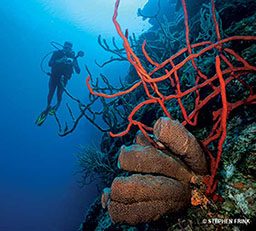Q: My son and I have been mapping the bottom of a quarry. We did several dives last weekend; each was about 30 feet deep and 45 minutes long. The water was cold, so we decided to run (about a mile) around the quarry between dives to get warm. We started running about 10 minutes after coming out of the water. To our surprise, we ran much better and were able breathe more easily than usual. I understand it may be inadvisable to exercise too soon after diving, but I wondered if you could explain why we found breathing while running so much easier after diving. It was a complete surprise to both of us — we thought we’d be sluggish, but just the opposite was true.
A: The factors captured by your question are actually quite complicated and bridge a number of issues. First, the recommendation against exercise after diving is based on decompression safety. Vigorous exercise and/or high joint forces can promote bubble formation and increase the risk of decompression injury. The simplest way to visualize this effect is to compare the result of opening a bottle of soda that has been at rest and one that was shaken before opening. While avoiding unnecessary exercise after diving is a sound general recommendation, the relatively benign nature of the dive profiles you described make this less critical. (Please note that “less critical” does not mean unimportant, just that the exposure you described is not as high on the risk scale as many dives might be.)
The next consideration is the impact of immersion, breathing equipment and person. The combined effects of a blood shift to the chest (primarily caused by the hydrostatic pressure of water, potentially magnified somewhat by additional cold stress), elevated breathing resistance from the mouthpiece — which can vary substantially depending on body position, depth (due to changing gas density), level of exercise and the characteristics of the regulator itself — state of hydration (being overhydrated can increase the likelihood of respiratory problems) and miscellaneous factors such as age, gender, constrictive equipment and physical fitness can lead to a degree of respiratory compromise after diving. If enough of these small factors work together, a swimmer or diver may develop a condition known as immersion pulmonary edema, in which excess fluid enters the lungs and compromises breathing during or following a dive. The solution is to try to reduce the impact of each element, a goal divers may achieve consciously or unconsciously. Some protection is provided by maintaining a normal pattern of good but not excessive hydration and by maintaining an optimal body position and low exercise intensity during dives to reduce breathing effort.
Immersion, especially in cold water, can induce some respiratory compromise. Mild impairment may not be noticed postdive because of the more obvious benefits of removing the regulator, dropping the heavy gear and having to work only against air. I suspect that your sense of ease was more perceptual than actual.
Ultimately, while you may feel good postdive, the dive has still stressed your system. For this reason I would discourage strenuous exercise. The postdive period is the right time to take it easy. Establishing a habit of keeping physical effort low after diving may offer important protection since some dives are less benign than others. Think of this as inexpensive insurance for long-term health and safety.
— Neal W. Pollock, Ph.D.
Q: I know that women are advised not to dive while pregnant, but is it a good idea to take a dive trip while trying to conceive?
A: Due to the strong ethical concerns raised by prospective study of this issue, the literature that addresses this topic is limited. What is available comes from case reports and surveys, which are summarized by Dr. Maida Beth Taylor in the book, Women and Pressure: Diving and Altitude (Dr. Caroline Fife and Marguerite St. Leger Dowse, eds., Best Publishing, 2010).

A few studies suggest an increased risk of birth defects associated with diving while pregnant. One retrospective questionnaire surveyed 109 women who dived before and during pregnancy; 69 of those women stopped diving once pregnancy was confirmed. Among the 40 who continued to dive, the survey suggested higher rates of low birth weight, birth defects and neonatal respiratory difficulties relative to the group that stopped diving. Taylor wrote, “Of particular interest is the list of defects reported: multiple hemivertebrae, absence of a hand, ventricular septal defects, possible coarctation of the aorta, hypertrophic pyloric stenosis and a birth mark.” These reports must be taken in context, and when other data on this topic are aggregated, “[a] calculated rate for these limited reports suggests a 2.7 percent rate of serious anomalies, consistent with the estimated incidence of major congenital anomalies (2 to 3 percent) reported in the USA, Canada, the United Kingdom and Wales.”
According to Taylor, the developmental risk to a fetus when the mother dives during the first trimester appears to be “vanishingly small.” As more women avoid diving when pregnant or when trying to conceive, the availability of cases will continue to decline, and data will remain limited. Despite the lack of hard evidence, concern about potential links to birth defects leads to the reasoned recommendation to refrain from diving during the periconceptional period as well as during pregnancy.
— Nicholas Bird, M.D., MMM
Q: On a recent dive trip I touched a sponge and was not wearing gloves. The next morning I woke up with my hand swollen and itching. I didn’t think sponges were harmful; can they really cause a rash?
A: Most sponges are harmless and not associated with human illness. However, unprotected contact may result in an itchy rash that can develop in as little as 10 minutes or up to a few hours following contact and may take several weeks to resolve. Symptoms can include itching, burning, localized swelling, blister formation and desquamation (shedding of outer skin layers). Rare systemic manifestations include fever, chills, malaise, nausea, vomiting and dizziness. Fortunately, most skin symptoms are relatively mild and are similar to dermatitis that can follow contact with other mildly toxic marine animals. Skin symptoms may result from allergic, sting or spicule-induced reactions, and differentiating among these potential sources can be difficult.

Reactions may be the result of contact with organisms that colonized the sponge such as other Echinoderms, Cnidarians (including polyps) or bristle worms. (These sorts of reactions are known as “sponge diver’s disease.”) A few sponge species are known to cause severe reactions; these include the Hawaiian or West Indian fire sponge (Tedania ignis) and the poison bun sponge (Neofibularia nolitangere). Signs and symptoms of contact are more likely in areas of the skin with existing lesions, open wounds and or when contact is made with the silica or calcium-carbonate spicules embedded in the sponge’s structural tissue.
Gently dry the affected area, and remove any foreign material. Spicules should be removed if possible using adhesive tape, a thin layer of rubber cement or products used for facial peels. Soak the affected area with vinegar for 10 to 30 minutes, three or four times a day. Wash the skin with soap and water, and keep it clean, dry and exposed to air. Leave blisters intact, and monitor for signs of infection. Steroid ointments may prove useful in reducing skin irritation, and a tetanus vaccination or booster may be recommended. Medical management may include corticosteroids, antihistamines or other medications used for severe reactions.
Avoid direct contact with sponges — don’t handle them with bare hands. Dry sponges may remain toxic or regain toxicity upon rehydration. Those providing first aid should wear protective gloves to minimize the risk of skin irritation from stings or contact with spicules.
— Matías Nochetto, M.D., and Nicholas Bird, M.D., MMM
Q: I have a blood condition called polycythemia vera. Will it affect my ability to safely dive?
A: This condition is a potential concern for divers. Diving has an intravascular (within blood vessels) dehydrating effect that is largely due to an increase in the volume of blood that passes through the kidneys. The increased pressure on the body and exposure to cool water associated with immersion cause blood to be shunted away from the periphery toward the vital organs and the core. This altered distribution can increase the workload on the heart and increases the amount of blood sent to the kidneys. (This is why diving seems to make you have to urinate more.) The net effect is that divers, especially those doing repetitive dives, will experience reduced intravascular blood volumes (reduced fluid, not reduced blood-cell count).
Decompression stress, the physiological stress the body experiences when on-gassed inert gas (e.g., nitrogen) is released in the form of bubbles, can have an intravascular inflammatory effect that triggers the clotting cascade. The presence of intravascular bubbles is common after diving, but the inflammatory response the bubbles can trigger has the knock-on effect of causing platelet activation that can result in sludging (thickening) of blood. This sludging can be worsened by underlying dehydration or the elevated risk of increased blood viscosity associated with polycythemia vera. Decompression sickness (DCS) is associated with intravascular inflammation, and the risk of experiencing DCS appears to increase with reductions in intravascular blood volume associated with dehydration or blood disorders that increase viscosity.
I am unaware of any specific research on the topic of polycythemia and DCS, but textbooks on diving medicine recommend against diving because of this anticipated increase in DCS risk.
— Nicholas Bird, M.D., MMM